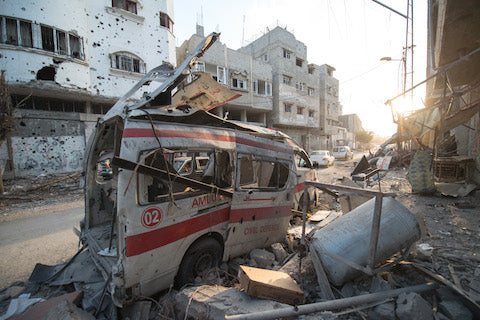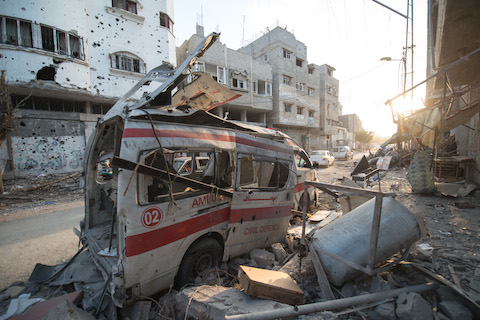The 51 Day War: Max Blumenthal's unflinching look on Israel's brutal attack on Gaza in July 2014

For the rest of week's blogs reflecting on the bombing of Gaza, follow the #July 8 - Gaza Conflict tag on our blog.
- 51 Day War: Resistance and Ruin in Gaza is published in July by Verso and is available to purchase for 40% off the retail price from our website.

A destroyed ambulance in the city of Shijaiyah in the Gaza Strip
The Resistance
By July 16, after eight days of relentless aerial bombardment of the Gaza Strip, and on day 9 of the 51 Day War, the Palestinian death toll stood around 200. Among the dead were eight members of the Kaware family, who were killed in the southern city of Khan Yunis by a guided Israeli missile. They had reentered their home after momentarily evacuating, only to have the house collapse on their bodies. The Israeli military initially claimed the bombing was a mistake, yet they ultimately justified it on the basis of the family’s alleged affiliation with Hamas. Another Israeli missile struck the beachside Fun Time Beach Cafe south of the city, where nine young men—who had gathered during an electricity outage in Khan Younis to watch the World Cup—were blasted to pieces. “And the result from this match here? The Jews won 9–0,” one of the survivors, Ahmad al-Aqad, remarked to Agence France Press afterwards.
On July 16, Israeli naval gunboats lobbed a shell towards a group of young boys playing on the beach. Journalists assembled at the Al-Deira hotel restaurant watched in astonishment from two hundred meters away. As the boys ran from the explosion for the safety of the hotel, they waved for help from the journalists. The Israeli gunners readjusted their sights to lob another shell at the boys, all members of the Fatah-aligned Bakr family that earned its keep in Gaza’s fishing industry. “They are only children!” a group of reporters shouted. “In the space of forty seconds, four boys who had been playing hide-and-seek among fishermen’s shacks on the wall were dead,” wrote Peter Beaumont, a correspondent for the Guardian who witnessed the incident. Footage of the shelling captured by the dozens of photographers and camera people on the scene made it one of the war’s iconic moments, transforming the four Bakr boys and their failed flight to safety into a symbol of young lives cut short by Israeli violence.
To date, one Israeli had died in the rocket salvos launched by the Izz Ad-Din Al-Qassam Brigades, the guerrilla group that functioned as the military arm of Hamas. The Al-Qassam Brigades operated cells within the West Bank and in Jerusalem, where affiliates could be activated at a moment’s notice to carry out deadly attacks on Israeli civilian targets. But the organization’s strategy had changed since it fell under the control of a new breed of leaders intent on developing its military capacity to compete in the field with the best of Israel’s special forces. The bus bombings and random shootings of the past were no longer a priority. Al-Qassam now focused its most lethal force on military targets, aiming to humiliate Israel’s ground forces in face-to-face confrontations.
The Al-Qassam Brigades drew its ideological inspiration from the days of the Arab Revolt of 1936–39 in the British Mandate for Palestine, naming itself after Izz ad-Din al-Qassam. Al-Qassam was a militant Islamic preacher and veteran of anti-colonial agitation in Libya and Syria, and was based in Haifa in northern Palestine. There he served as a functionary in the local shariah court and helped lead the Young Men’s Muslim Association, offering him direct access to the masses of dispossessed peasants pouring into the city. Many of the impoverished farmers had been run off the land they rented from absentee landlords by the Jewish National Fund. So Al-Qassam found no shortage of eager recruits among them for the Black Hand cells he organized to carry out armed attacks on British and Zionist targets. Killed in a dramatic shoot-out with British forces in 1935, where he was said to have exhorted his men to fight to the last bullet and accept their martyrdom with zeal, Al-Qassam became a symbol of defiance for Islamist and secular Palestinians alike. For Hamas, his legacy represented the cultivation of grassroots support through a blend of social welfare programs, religious ardor, and anti-colonial resistance.
Al-Qassam began organizing its original nucleus of fighters in the mid-1980s, recruiting on university campuses and cultivating young members in the growing network of Hamas-affiliated mosques. It drew its most enthusiastic cadres from impoverished youth orphaned or otherwise scarred by Israeli violence, promising them a chance at retribution and an honored place in society. By 1991, Al-Qassam Brigades had just a single rifle, a 1960s-era 9mm Carl Gustav M45 submachine gun that barely functioned—bullets fell from its barrel to the ground once the weapon heated up. Without the capacity to confront Israeli soldiers directly or to attack the settlements in Northern Gaza, most Al-Qassam attacks were aimed at collaborators, the Palestinians who had been compromised or induced into spying on fellow Palestinians. As Al-Qassam’s offensive capacity progressed with the development of homemade rockets and the ability to shell settlements with mortars, those collaborators enabled Israel’s Shin Bet intelligence service to pick off its leaders, one by one.
Imad Aqel, an early commander of the Al-Qassam Brigades’ original cell, spent two years as a fugitive after an audacious and lethal attack in 1992 on Israeli settlers in Hebron. After slipping back into Gaza from the West Bank disguised as a Jewish settler, he hid out in a tunnel under his home before a collaborator gave up his location, leading to his death at age twenty-two. Aqel’s successor, Yahya Ayyash, was an explosives expert known as “The Engineer” who was also a master of disguise—he attended the funeral of a comrade dressed as a woman. When the American-born Jewish fanatic Baruch Goldstein massacred twenty-nine Palestinian worshippers at the Ibrahimi Mosque in Hebron, on February 25, 1994, Ayyash stepped up Al-Qassam’s campaign of revenge, initiating a wave of suicide bombings that tormented Israeli society. After a frenzied search by the Shin Bet, Israel’s intelligence services finally caught up with the elusive Engineer in 1996. He was killed at a safe house when one of his best friends passed him a mobile phone that turned out to be packed with explosives by a collaborator—his friend’s uncle. The charge was detonated by an Apache helicopter hovering in the area. Ayyash was succeeded by Salah Shehadeh, a skilled guerrilla organizer who died in 2002 when an Israeli F-16 dropped a 2,000-pound bomb on the apartment compound where his family resided, killing him and fourteen others, including seven children. As in the past, a collaborator had given up Shehadeh’s location.
Both Ayyash and Shehadeh’s assassinations occurred during periods of truce between Hamas and Israel, and led to severe interruptions of the peace process. For two months, Ayyash had abided by an agreement to cease attacks on Israeli targets when then-Prime Minister Shimon Peres—a figure widely identified with Israel’s so-called “peace camp”—authorized his killing. “The act disillusioned many moderate Hamas members in the territories who were willing to give the peace a chance,” international relations professor Alon Ben-Meir wrote at the time. “It has embarrassed the Palestinian Authority and undermined Chairman Yasser Arafat’s credibility.” During the height of the Second Intifada six years later, Israel made the decision to kill Shehadeh as Palestinian factions introduced a proposal for a unilateral ceasefire aimed at returning to negotiations. The killing reinforced the perception among Hamas’s political leadership that negotiations with Israel were fruitless.
It was under the leadership of Mohammed al-Deif, who took over after Shehadeh’s assassination in 2002, that the Al-Qassam Brigades began to transition away from the kind of suicide operations on civilian targets overseen by Ayyash. Deif took extreme measures to cover his life in a veil of secrecy. He did not use a cellphone, preferring instead to relay verbal messages through a handful of close associates. He never appeared in public, not even to attend his own mother’s funeral. Born as Mohammed Diab Ibrahim al-Masri, he was nicknamed Deif, or “guest” in Arabic, because he was constantly on the run from Israeli assassination plots, making him a perpetual guest in homes across Gaza.
Israeli intelligence was at least as obsessed with eliminating Deif as it was with his forerunners, attempting to kill him at least five times. The closest it came to assassinating Deif before Operation Protective Edge was in 2002, when an Apache helicopter found him driving through the Sheikh Radwan neighborhood of Gaza City. Deif’s driver was killed but Deif managed to emerge from the burning wreck. The cumulative attempts on Deif’s life have left him blind in one eye and partly immobilized, only able to walk for short distances.
When Deif escaped to Egypt to receive medical care for his injuries, his role was filled by another veteran Hamas cadre named Ahmad Jaabari. Jaabari had proven indispensable in Deif’s absence, continuing the transformation of AlQassam into a professional guerrilla force along the same lines as Hezbollah, a goal he shared with Deif. Jaabari masterminded the daring tunnel operation that brought the Israeli soldier Gilad Shalit into captivity on June 25, 2006, prompting the deal five years later with Israel that led to the release of more than 1,000 Palestinian prisoners. The swap was arguably the most substantial concession any Palestinian faction had extracted from Israel since the Camp David negotiations collapsed in 2000. Despite his widely reported role in negotiating several ceasefire agreements and in overseeing the safe release of Shalit, Jaabari wound up at the top of the Shin Bet’s target bank. During the November 2012 military escalation in Gaza known as Operation Pillar of Defense, a military stalemate that saw Israel attack Gaza exclusively by air, Israel assassinated Jaabari in a targeted airstrike. Deif, who had returned to Gaza through a tunnel from Egypt, was now in full command of Al-Qassam—and at the top of the Shin Bet’s hit list.
Thanks to the ingenuity of Deif’s late comrade, Adnan al-Ghoul, Al-Qassam was able to initiate the local production of the short-range rockets and the Yasin RPG-7 rocket launcher that remains at the forefront of the organization’s arsenal. (Al-Ghoul was assassinated by the Israeli military in 2004.) Under al-Ghoul’s watch, Al-Qassam even began exploring plans to develop weaponized drones, an effort that was finally realized during Operation Protective Edge when the group flew its first drone over Israeli territory. By 2012, Al-Qassam boasted that locally made long-range rockets like the M-75 and R-160 could reach centrally located Israeli cities. During the military escalation that took place in Gaza that year, rockets struck Tel Aviv, marking the first missile attack on the city in twenty years. Though the rockets did little structural damage, they shook the psyche of Israeli society and fostered a sense of redress to Palestinians withstanding the brunt of the Middle East’s most powerful military. During the 2012 escalation, a fast-paced pop song with a taunting tone thumped from shops and cars from Ramallah to Gaza City. Conceived by a popular wedding singer from the West Bank, Qasem El-Najjar, the song was called “Bomb, Bomb, Tel Aviv.”
